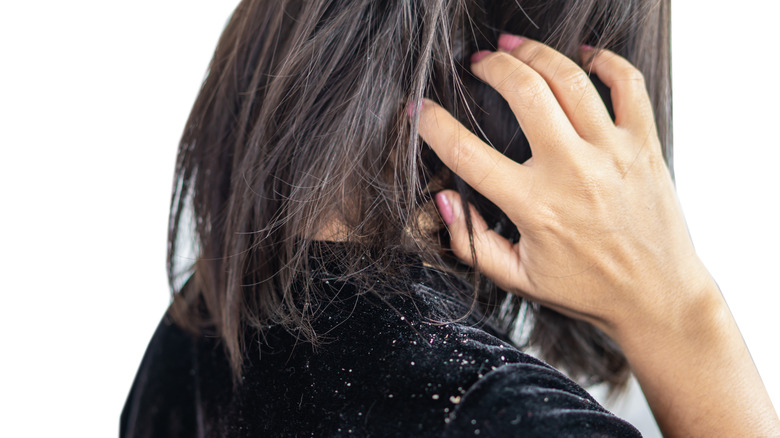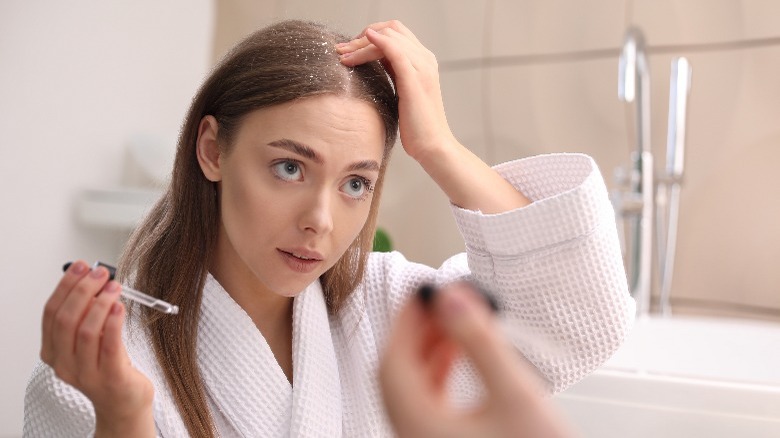What's The Difference Between Wet And Dry Dandruff? We Break It Down
According to a review published in the Journal of Clinical and Investigative Dermatology, dandruff affects the scalps of around 15 percent of Americans. It is usually easily treatable, depending on the severity and type of dandruff at play.
Everyday Health describes the condition as being characterized by an itchy scalp and obvious skin flaking along the surface of the hair. However, there's more than just one type of dandruff. Two broad types include wet and dry dandruff, with dry dandruff being more common. The main difference between the two is how they feel and look on the scalp.
Contrary to popular opinion, dandruff is an isolated symptom of something else happening in the body that manifests on your scalp. Thus, it can be caused by a variety of factors, including fungal overgrowth and different illnesses. You might want to consider how many times a week you wash your hair, as dandruff can also be caused by a lack of hygiene, and not maintaining a proper washing routine can worsen the condition. Other than that, factors such as genetic predisposition, age group, and ethnicity can contribute to the possibility of dealing with some type of dandruff.
Both types can be symptoms of illnesses
Dry dandruff is characterized by white, dry flakes of skin that don't cling to your hair, as per Verywell Health. The scalp can feel irritated and appear red, and the root cause can be anything from sensitivity to certain beauty product ingredients, a dry scalp, or even different illnesses like psoriasis and fungal infections.
On the other hand, wet dandruff can seem wet to the touch, but it's actually just greasy; that's why it's also known as oily dandruff. Wet dandruff is distinguished by larger yellow flakes that mix with scalp oils and therefore stick to your hair and scalp.
"[Wet dandruff] can mimic the symptoms of seborrheic dermatitis, scalp psoriasis, and eczema," Anna Chacon, MD, a double board-certified dermatologist, illustrates to Stylecraze, adding that the condition can lead to hair loss if not treated properly. Unlike dry dandruff, wet dandruff is more often caused by bad hygiene habits, according to Verywell Health, but it can also appear as a symptom of scalp ringworm, psoriasis, and dermatitis.
Both can be tackled at home
For wet dandruff, the treatment will depend on the cause of the condition. If you're just not shampooing enough, establishing a regular washing routine with products that specifically tackle dandruff will most likely rid you of the problem. Maybe skip washing your hair with just conditioner and incorporate a clarifying shampoo for a deeper clean.
DIY treatments could also help if your wet dandruff isn't severe. Arnica can help treat sensitive skin on the scalp, as can aloe vera, while apple cider vinegar and fenugreek seeds will help tackle the fungus causing the dandruff, per Stylecraze. However, as wet dandruff can be a symptom of something else, like dermatitis or psoriasis, make sure to visit a dermatologist if you don't see a change in your scalp's health. There are OTC and prescription options available for treating wet dandruff successfully.
Dry dandruff is usually much easier to handle and will most likely go away when you swap out your regular shampoo for one containing dandruff-fighting ingredients. According to a study from The Journal of Clinical and Aesthetic Dermatology, zinc pyrithione and selenium sulfide are most effective; just make sure you're not skipping wash days. Again, if the state of your scalp doesn't get better relatively quickly, lay off the DIY approach and visit a dermatologist for a professional opinion.


